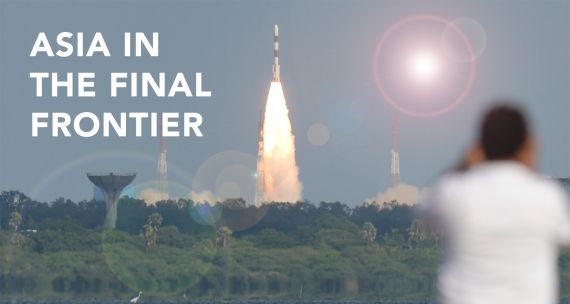China is making significant strides in its quest for space superiority. One notable initiative, the SpaceSail network — a mega-constellation of low-Earth orbit (LEO) satellites designed to deliver global broadband internet services — is set to become operational in select countries later this year. Nearly 100 satellites have already been launched, with an additional 500-plus expected to be in orbit by the end of 2025. SpaceSail’s parent company, Shanghai Spacecom Satellite Technology (SSST), aims to have the network fully operational by 2030 with a constellation of some 15,000 satellites.
SpaceSail recently made headlines by securing service contracts with Brazil, Kazakhstan, Malaysia, as well as Thailand. Once operational, SpaceSail will stand as the only comparable rival to Starlink — the world’s first and largest satellite network developed by SpaceX.
In 2018, SpaceX launched its first test satellites for its Starlink constellation,which was seen as something of a ‘Sputnik moment’ for China’s space industry. Mega-constellations comprising tens of thousands of satellites have the potential to revolutionize global high-speed internet access, making it more accessible, precise, and resilient to physical destruction compared to ground-based networks. For China, developing its own satellite internet constellation became a strategic priority both for its use in military operations and deployments, and as a demonstration of its technological and geopolitical strengths. There is also a sense of urgency for China: if America’s Starlink, slated to deploy tens of thousands of satellites in LEO, is faster in occupying all the best frequencies for satellite internet, it could constrain China’s mega-constellation program and leave it on the back foot in the U.S.-China space race.
As an enterprise backed by Shanghai’s municipal government, SSST’s ability to undertake this highly ambitious project is a manifestation of China’s industrial policy being decentralized. While the China National Space Administration oversees the country’s national space missions, an increasing share of initiatives is carried out by local governments. Shanghai’s government, in this case, has committed comprehensive policy efforts to develop a conducive environment and a localized supply chain to bolster SpaceSail’s likelihood of success.
Beyond top-down, state-led initiatives, subnational governments in China enjoy considerable autonomy to experiment with the development of the country's commercial space industry. They are in an advantageous position to do so as they are in closer proximity to commercial partners, thereby nurturing innovators such as SSST, which are sufficiently robust to attract private investment. The competitive dynamic among different regions — often overlooked in discussions about China — drives them to vie for leadership in key sectors.
Shanghai’s policy support created conditions for SpaceSail to grow
In recent years, China has seen the planning of several mega-constellation programs, including the Beijing-backed Guowang constellation in 2021, the SpaceSail project in 2023, and the Honghu-3 constellation in 2024 by a Shanghai-based private company. Shanghai has emerged naturally as a hub for large-scale satellite projects, leveraging its leadership in smart manufacturing and its capacity to rapidly scale satellite production, giving it a significant advantage over nascent space clusters.
In 2023, the Shanghai city government unveiled a landmark three-year action plan to advance commercial space development and position the city as a national leader in the spatial information industry. Economies of scale are expected to enhance Shanghai’s ability to commercialize key technological breakthroughs, including the development of reusable launch vehicles— an essential technology for reducing costs and ensuring the sustainability of satellites. This advancement will be crucial for the success of mega-constellations, especially as China still trails a decade behind America’s SpaceX in this domain.
This is not the first time that Shanghai has sought to leverage such a cluster effect. Prior to the 2023 action plan, the municipal government established in 2021 a new ‘G60 industrial base’ specifically for the SpaceSail project. The creation of industrial bases is a common practice in China, where designated areas are set up for upstream and downstream industries — in this case, satellite design and satellite application incubators — to collaborate and form an integrated industrial chain. Located near an existing cluster of digital economy and 5G communication companies, the base has achieved a production capacity of 300 satellites annually with the potential to double, while reducing production costs by 35 per cent. Establishing this infrastructure ahead of the SpaceSail network’s launch provided a strong foundation for that project’s rapid growth.
Financial support, which constitutes a significant component of Shanghai’s policy measures to bolster this critical industry, plays a vital role in launching some of the emerging players. SSST exemplifies this, having benefited from both government funding and policy-guided access to private capital. This trend was encouraged by the city government following the 2014 national marketization reforms in China’s aerospace sector, which relaxed restrictions on private sector investment — including from foreign investors with specifications — in the emerging commercial space sector. In 2024, SSST successfully secured C$1.33 billion (6.7 billion yuan) in its Series A funding round from a diverse mix of public and private investors, representing the largest single-round funding raised by a Chinese satellite venture to date.
As China’s financial centre, Shanghai provides a business-friendly environment with various grant and funding programs supporting innovative initiatives in the space sector. SSST was initially founded with capital from the municipal state asset management commission and Shanghai Alliance Investment, a state-owned venture capital firm specializing in emerging technology investment and incubation. Many of the company’s key shareholders, most of whom have links to the city government, have supplied not only financial resources but also complementary capabilities essential to SSST’s projects. For instance, Microsat, China’s leading institution for scientific satellites, is a stakeholder involved in the assembly and testing of SpaceSail’s satellites.
In April, Shanghai announced its latest measures to further ramp up financial support for companies developing core space technologies, including commercial rockets, satellites, and terminals, to C$57.5 million (300 million yuan) in subsidies. The government will also subsidize manufacturing upgrades and offer loan discounts to promote industrial upgrades. Companies engaged in rocket launches and constellation construction are also eligible for insurance subsidies worth several million dollars. These financial measures aim to ensure that private sector space programs, which often entail substantial costs, receive adequate support to sustain their efforts and achieve meaningful results.
Additionally, much of the infrastructure proposed in Shanghai’s three-year action plan builds upon ongoing efforts to cultivate human capital by making the city an attractive place to live and work. These initiatives include funding for new labs, research institutes, and technical collaboration platforms, as well as outreach programs to higher education institutions to attract top talent.
Drive for internationalization could face headwinds
One of Shanghai’s key priorities for its commercial space sector in 2025 is internationalization. Currently, China’s space industry primarily serves domestic demand, which limits the international growth of its companies. A policy proposal presented at Shanghai’s local-level ‘Two Sessions’ this year stressed the need for government efforts to help space enterprises tap into international markets. Suggested measures include establishing cross-national space R&D centres and labs to allow Chinese space companies to collaborate with international counterparts and facilitating the export of aerospace parts and technologies where the situation allows. The proposal also highlighted regions such as Belt-and-Road countries, Arab states, Africa, and Asia as strategic markets for China’s expanding space sector.
International partnerships will benefit the SpaceSail constellation by providing greater access to the global knowledge pool, fostering innovations in the development of much-needed reusable launchers. However, pursuing international collaborations with other space-faring nations may encounter significant challenges, given the sector's competitive nature and potential national security implications. If Canada and other Western countries that are leaders in space technologies want to effectively compete with China in this area, they will need to take note of how China is using industrial policy at scale to develop these clusters and national champions — essentially the same process through which it came to claim dominance in the electric vehicle, solar, and other critical sectors. To remain competitive, Canada and its allies need to offer comparable levels of funding and policy support to their private sectors. Moreover, understanding China’s strategy of empowering regional governments with a more active role can provide valuable insights for Canada and others as they craft policies to sustain their competitive edge in the space sector.
Conclusion
China’s industrial policies are frequently characterized by substantial state subsidies; however, the role played by its local governments is often understated. While much attention is focused on Beijing’s efforts to advance industrial and technological prowess amid the ever more complex trade tensions with Washington, the progress of initiatives like SpaceSail serves as a reminder to observe how these national priorities are, at a practical level, translated into actions across provinces and cities.
While state sponsorship can be effective initially, it often encounters inefficiencies beyond the beginning stages, making it essential for the commercial sector to take the lead in driving ongoing innovation. The SpaceSail program, primarily orchestrated by Shanghai’s municipal government, serves as an example of the role of local government in providing policy, financial, and cluster-building support to advance national objectives, in this case, fostering flagship projects and the sustainable growth of China’s commercial space industry.
From Shanghai’s perspective, building a successful space industry cluster and flagship initiatives serve both political and economic objectives. Satellite internet services, in particular, have the potential to be highly profitable in international markets and can be touted as a performance indicator that aligns well with Beijing’s political goal of excelling in high-tech competition. As China continues its pursuit of space dominance, it is vital for observers to recognize the important role played by municipal governments, as monitoring these local dynamics is essential for understanding the future trajectory of China’s space industry.
• Edited by Vice-President Research & Strategy Vina Nadjibulla and Director of Research Charles Labrecque, APF Canada






